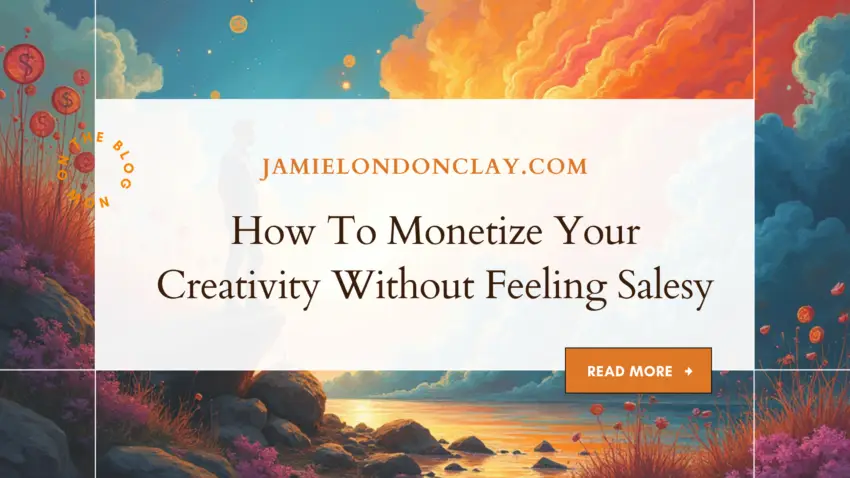Many creators aim to earn money in the fast-changing creative economy, valued at around $985 billion. They aim to do this while staying true to themselves and not appearing too commercial. By 2030, this sector will make up 10% of global GDP. About 52% of content creators have found ways to make money. Among them, women make up 78%.
To navigate this landscape, shifting your perspective on monetization is essential. Seeing sales as part of your creativity lets you share your passion with those who need it. Embracing this mindset helps you match your financial goals with your creative values. This way, your work can reach a wider audience while maintaining integrity.

Introduction: Monetizing Creativity Without Feeling Salesy
I often wonder how to share my creative gifts with the world while staying true to who I am. Spiritual and financial success can go hand in hand, and creativity is a way to heal. Own your gifts without saying sorry. This way, we can change old patterns and shape our futures. This belief has shaped my choices about sharing and making money from my work.
Turning creative work into income is tricky. You need to balance art and commerce. For me, I must not sacrifice authenticity for profit. When I focus on my passion, financial rewards often appear. This happens because I do genuine work and build real connections. In this article, I share my experiences and tips on monetizing creativity. You can do this without using high-pressure sales tactics. I want to show you that you can build a creative career while keeping your values intact.
Embracing Your Unique Creative Gifts
Many creators struggle to set a price on what feels personal. I remind myself that my creative output has intrinsic worth. Claiming ownership of my gifts without apology gives me the confidence to share what I love. When earning from my creativity, I aim to grasp its value. I examine my skills, explore my interests, and consider how my view could benefit others.
Authenticity signals quality. When people see genuine care behind creative work, they connect with it. This authentic connection often brings steady income without a tough sales pitch. Building this mindset takes time, self-reflection, and trying new things. We must acknowledge both our creative work’s emotional value and financial rewards. Believing in the value of our creative work is the first step to making money.
Aligning Authenticity with Monetization
A common fear among creators is coming across as pushy when discussing their work. I used to fear discussing prices or sharing marketing tips would spoil the art. Over time, I saw marketing as a way to connect with people who value my work. Sharing my creative process and the stories behind my work helps start honest conversations, often leading to support and sales.
See monetization as a way to enhance creative impact, not a way to sell. I share my journey. It includes the challenges, lessons, and successes of pursuing my passion. This honest narrative makes the financial aspect feel like a reward for doing what I love. To me, authenticity means setting realistic goals. It also means being open about my creative process. This includes sharing the time and resources I use. This transparency builds trust with my audience. It makes the money exchange a fair reflection of our mutual value.
Practical Strategies for Low-Pressure Marketing
When I decided to make money from my creativity, I sought ways to keep my authentic voice. I used methods that educated and inspired me and avoided commercial-sounding language. One approach was creating content that showed my process step by step. I create blog posts, tutorials, and behind-the-scenes videos, which show how my creative work grows.
I offer real value first so viewers can connect with my work without a sales pitch. I also use social media to share stories instead of pushing sales messages. My followers love it when I share images, short videos, or thoughts about my creative routine. They appreciate my passion. They are more likely to back projects if they see a meaningful journey behind each piece.
Below are some simple steps I follow to keep my marketing low-pressure and authentic:
- Share accurate behind-the-scenes content. Show the creative process, not the final product.
- Engage with your audience. Answer their questions and share insights about your daily routine.
- Create value-driven content that addresses common questions or challenges your audience may face.
- Offer free resources or mini-tutorials to build trust before presenting any paid options.
This approach has helped me build a community that appreciates my creative vision. The strategy feels more like sharing my journey than a sales pitch.
Setting Up a Creative Business with Personal Integrity
Turning creativity into a business does not mean compromising who you are. A successful creative business relies on strong personal values and clear communication. I created a clear plan that helped me achieve my vision. It allows me to create both art and income while keeping my ideals intact.
The first step was to set clear creative and financial goals. I broke down my vision into smaller, actionable steps. I wanted to improve my online presence. I aimed to create a portfolio that showed my style. Also, I tried to set fair prices for my clients and myself.
One essential element was creating an online portfolio that showcases my work. This website is a hub for potential clients. You can look at my background, see past projects, and contact me for commissions or purchases. I update the site consistently with new work and provide a detailed explanation of my services.
A key step in starting my creative business was setting a clear pricing strategy. I researched industry standards, looked at my experience, and tested different pricing models. I always aimed to balance affordable prices for clients with fair pay for my time. This planning has allowed me to discuss fees with assurance. I no longer worry about looking too commercial.
Overcoming Common Challenges in Monetizing Creativity
Every creative professional faces hurdles. I learned to face these challenges by making plans that reflect my values and solve real issues. One frequent issue is the fear of coming off as pushy or commercial. Focusing too much on selling could disconnect my art from my audience. To tackle this, I focus on honest communication. I share my successes and the challenges I face.
Another challenge is determining the correct pricing for creative work. Deciding how much to charge is not easy. I handled this by reviewing all parts of each project, including time, materials, and the emotional effort required. This evaluation helped me set prices that match the value of my work. I listen to feedback and change my pricing models when needed. Talking about fees with potential clients now makes me feel more confident.
Patience is also key. Monetizing creativity is not an overnight process. Building an audience and developing a reputation for quality work takes time. I remind myself that hard work and being true to myself will bring opportunities. To handle these challenges, take a steady and practical approach. Allow for learning and growth.
Advanced Tactics and Collaboration Opportunities
Once I mastered the basics, I researched strategies to expand my reach and boost my income. Collaborations with other creators and complementary businesses have opened up new opportunities. Working together can improve both creative output and financial prospects. I’ve joined forces with bloggers, digital platforms, and educational sites. Together, we share value without relying on standard sales pitches.
These collaborations aim to boost creative work that benefits everyone involved. I also experiment with tactics such as limited-time offerings and exclusive content. I sometimes launch special projects or themed collections. These invite my audience to take part. In doing so, I help create a sense of community and shared passion for creativity.
Here are a few advanced tactics that have worked for me:
- Host virtual workshops to share creative techniques and offer exclusive content to participants.
- Create membership or subscription plans that provide access to creative resources.
- Join online collaborations and challenges. They boost your visibility and help you connect with other creators.
- Create limited-edition prints or digital products to celebrate milestones or seasonal themes.
These strategies grow my creative network, but I’m careful not to change too much. I want to keep my authentic voice. I keep refining my approach. I stay aware of the balance between art and commerce.
Frequently Asked Questions
I often get asked how to make money from creative work. People want to know how to avoid hard-selling techniques. Here are some common questions and my answers:
To start making money from your creative work without being pushy, try these steps:
- Build an Online Presence: Share your work on social media and a personal website. This helps you connect with potential customers.
- Offer Free Samples: Give away a few pieces of your work. This allows people to see your style and value.
- Engage with Your Audience: Talk to your followers. Ask for feedback and respond to comments to build relationships.
- Work with Others: Teaming up with other creatives can help you reach more people and connect with new audiences.
- Create a Newsletter: Keep your fans updated on new work and special offers. This keeps them involved and interested.
- Sell-Through Platforms: Use online marketplaces that align with your work. They can help you reach more buyers without hard selling.
Following these steps can earn you income while staying true to your creative style.
Question: How can I start generating income from my creative work without using pushy sales methods?
Answer: Focus on building a trusted community around your art. Share the story behind your work and offer valuable content. As trust builds, discussions about commissions or purchases arise without difficulty.
Question: What strategies work best for pricing creative projects?
Answer: Check all parts of the creative process, including your time, materials, and effort. Check industry benchmarks. Test different pricing models. Find one that feels fair for you and your clients.
Question: How do I stay true to myself while promoting my work?
Answer: Honesty is key. Explain the hard work behind your creations and why they matter to you. Open communication helps your audience see the value in your projects, and they are more likely to support you.
Wrapping It All Together
Monetizing creativity does not need to compromise personal integrity. Aligning my art with my values helps me create a sustainable path. This process respects my vision while meeting my financial needs. It focuses on highlighting my unique voice. Those who connect with my story will support my work.
The journey is one of self-awareness, careful planning, and active engagement. I remind myself every day that the art I create carries deep meaning. Sharing meaning isn’t about pushing someone to buy. It’s about building connections that help everyone involved. Simple strategies and an honest view of my creative process give me joy and help me earn money.
I keep trying new ways to boost my creativity and improve my business model. I balance art and business, which helps me grow my opportunities and stay true to my values. If you’re on a similar path, try new methods. Share what you do, and trust that the value of your work will shine through over time. Success comes in many forms, and each step of this adventure is worth celebrating.
Making money from your creativity doesn’t mean losing your integrity. It means sharing your talents with the world in a way that feels right and satisfying. Shifting your mindset helps you build real connections. When you create value-driven offerings, you can earn money without feeling pushy.
You need guidance, strategies, and tools to do this well. That’s where Wealthy Affiliate University comes in. This platform offers clear training on how to build an online business. You’ll learn to monetize your passions and create lasting income streams. Best of all, you can stay true to your voice and vision.
As an affiliate marketer, I earn a commission when you sign up through my links. I only recommend resources that help you reach your highest potential. Check out my online store at jamielondonclay.com. You’ll find products that inspire and support your whole-person journey.
If you liked this article, subscribe to my blog. Follow me on social media, too. And share this with someone who could use it. Your input helps this community grow—so leave a comment below, and let’s chat! If you want deeper insights on this, subscribe to my YouTube channel. I’m starting, so be patient as I roll out content. Join me on this journey to whole-person development and financial freedom. What’s the first step you can take today to monetize your creativity on your terms?










Love this whole vibe—especially how you frame monetization as an extension of creative integrity, not a threat to it. That shift is everything. I’ve definitely been guilty of thinking “salesy = sellout,” but your take helps rewire that. Curious—what’s one mindset habit that helped you feel safe charging for your gifts without second-guessing?
Genie, thank you so much for this beautiful reflection. ???? You get it—that shift is everything. For me, the biggest mindset habit that helped me feel safe charging for my gifts was this: I stopped seeing my calling and compensation as opposites. Instead, I started affirming “My gifts are divine, and divine provision is my birthright.”
I reminded myself daily that being compensated for what flows from my soul doesn’t cheapen it—it honors it. Money simply becomes the energy exchange that allows me to serve more fully, from a place of overflow, not depletion.
So grateful this resonated with you. Let’s keep rewriting the story—no more starving artist or silenced soul. Only aligned impact, embodied abundance, and purpose-driven prosperity. ✨????